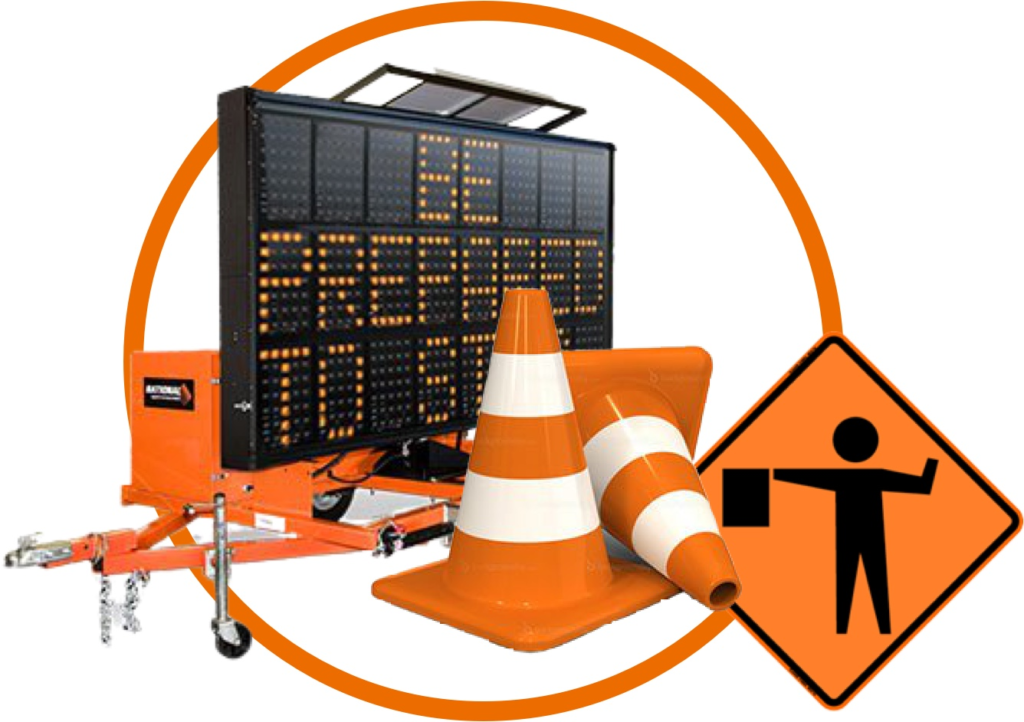Automated Flagger Assistance Devices (AFADs) are transforming the way crews control traffic around work zones. Rather than relying solely on human flaggers standing in the flow of vehicles, AFADs use remote-controlled signals to manage traffic safely and efficiently. In this full 2025 guide, Safety Network Inc. explains everything you need to know—definitions, benefits, setup, compliance, and best practices—to choose and deploy AFADs like a pro.

1. AFAD Defined: How It Works
Firstly, an AFAD consists of two main components:
- Signal Head Assembly: Typically a set of high-visibility red/green lights or half-signals mounted on portable stands or trailers.
- Remote Control Station: A wireless control panel or handheld device that the operator uses from a protected location off the roadway.
When traffic needs to alternate through a single lane—such as during road repairs or utility work—the operator presses a button to display “Stop” (red) on one side while allowing “Proceed” (green) on the other. After a preset interval, the signals swap automatically or at operator command, thereby alternating traffic without exposing flaggers to live vehicles.
2. Key Benefits of Using AFADs
A. Enhanced Worker Safety
- Reduced Exposure: Human flaggers no longer stand in the traveled lane, slashing the risk of roadside strikes.
- Protected Location: Operators manage traffic from behind concrete barriers or from the work-zone shoulder.
B. Consistent Traffic Control
- Predictable Timing: AFADs use standardized signal cycles, avoiding the human error of holding flags too long or too short.
- Traffic Sensors: Some models integrate vehicle-actuated sensors to optimize cycle timing based on actual traffic flow.
C. Cost Efficiency
- Lower Labor Costs: One technician can oversee multiple AFAD stations remotely, reducing the number of flaggers needed on site.
- Multi-Use Equipment: AFAD units can be redeployed across various projects, maximizing return on investment.
3. AFAD System Components
An AFAD system typically includes:
- Portable Signal Heads: Rugged LED lights with built-in radar or loop-detector receivers.
- Mounting Hardware: Adjustable tripods or trailer mounts for easy setup on asphalt or gravel.
- Control Console: A push-button unit with status indicators, timers, and emergency override.
- Power Supply: Battery packs, solar panels, or hybrid generators to run lights and electronics.
- Communication Link: License-free radios or encrypted signals to prevent interference or unauthorized access.
Moreover, advanced AFADs may offer smartphone integration, GPS-based geofencing, and real-time status monitoring via cloud dashboards.
4. Compliance and Standards
To ensure legal and safe operation, AFADs must meet:
- MUTCD Part 6D: Specifies signal head height, lens size, and timing parameters for temporary traffic control devices.
- OSHA 1926.200: Requires flagger protection and mandates that devices do not increase worker hazard.
- AASHTO Guidelines: Addresses site placement, sight distances, and signal spacing in work zones.
Consequently, choosing AFADs tested to these standards gives you confidence in their performance and compliance during inspections.
5. Setting Up Your AFADs: Step-by-Step
- Site Assessment: First, measure lane widths, shoulder slopes, and sight distances. Then, draft a temporary traffic control plan (TCP) to position AFADs per MUTCD spacing rules (typically 100–300 ft apart, depending on speed).
- Equipment Positioning: Next, place signal heads on sturdy mounts or trailers. Ensure they face oncoming traffic squarely, at least 7 ft above the pavement.
- Power & Communications: Subsequently, connect batteries or solar panels. Then, pair remote consoles with signal heads, confirming a reliable wireless link.
- Test Cycles: Finally, run through multiple stop/go cycles to verify timing, light intensity, and remote responsiveness. Adjust timers or sensor sensitivity as needed.
By following these steps, you set the stage for smooth operation and minimal driver confusion.
6. Best Practices for AFAD Deployment
- Operator Training: Ensure each technician completes hands-on training covering deployment, remote operation, emergency procedures, and equipment troubleshooting.
- Daily Inspections: Perform pre-shift checks of batteries, light lenses, and radio connections. Document results in a daily log.
- Emergency Procedures: Establish clear protocols for manual flagging or immediate signal shutdown in case of device failure or power loss.
- Maintenance Schedule: Clean lens surfaces weekly, replace worn batteries quarterly, and update firmware annually to maintain peak performance.
Through consistent upkeep and trained operators, you maximize AFAD reliability and work-zone safety.
7. Frequently Asked Questions (FAQs)
Q: Can AFADs replace all human flaggers?
A: AFADs reduce flagger exposure but do not eliminate the need for an operator. OSHA requires a competent person on site to manage equipment and handle emergencies.
Q: How long do AFAD batteries last?
A: Typical battery packs run lights and radios for 7–14 days. Adding solar panels can extend that indefinitely under adequate sunlight.
Q: Are AFADs suitable for high-speed highways?
A: Yes—MUTCD allows AFADs on divided highways and rural roads, provided sight distances, signal spacing, and attenuator protection meet standards.
Q: Do I need a permit to deploy AFADs?
A: Generally, AFAD deployment falls under your project’s existing traffic control permit. However, always confirm local jurisdiction requirements.
Q: What if the wireless link fails?
A: Operators can switch to manual flagging instantly or use backup wired connections where feasible. Emergency stop buttons are standard on all AFAD consoles.
Conclusion
Automated Flagger Assistance Devices offer a modern, efficient, and safer alternative to traditional flagging. By combining remote-controlled signals, standardized timing, and robust compliance with MUTCD and OSHA, AFADs help you protect workers and manage traffic smoothly. At Safety Network Inc., we provide expert guidance, certified AFAD systems, and full lifecycle support—from planning and deployment to training and maintenance.

